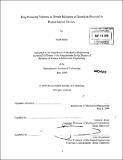Drag reducing polymers as simple indicators of hemolytic potential in biomechanical devices
Author(s)
Shieh, Sarah
DownloadFull printable version (5.561Mb)
Other Contributors
Massachusetts Institute of Technology. Dept. of Mechanical Engineering.
Advisor
Anette E. Hosoi.
Terms of use
Metadata
Show full item recordAbstract
An experimental study was carried out to determine if drag reducing polymers can be simple indicators of hemolytic potential in biomechanical devices. Specifically, three different blood pumps, known as a left ventricle assist devices (LVADs) were operated in a test loop using an aqueous solution of polyethylene glycol (PEO, MW = 5000 kDa), a known drag reducing polymer. The pumps were operated under controlled parameters and the change in viscosity (cP) and drag reduction (%DR) for each pump was monitored over the specified time period. The CentriMag® (CM) was used to confirm the drag reducing behavior of PEO, while HeartMate® II (HM II) and HeartMate® III (HM III) were used to determine if there was a correlation between experimental results and actual hemolysis results. Experimental results showed that the mathematical difference between the average final and initial viscosity of HM II was greater than the difference for HM III. HM II had a difference of 0.21 cP and HM III had a difference of 0.16 cP. Hemolysis results using bovine blood showed that HM II had a higher hemolysis rate of 3.80 +/- 1.11 g/day and a higher milligram normalized index of hemolysis of 0.0393 +/- 0.0155. The average hemolysis rate for HM III was 1.38 +/- 0.63 g/day and the milligram normalized index of hemolysis (mg N.I.H.) was 0.571 +/- 0.333. This positive correlation shows that PEO can be a simple indicator of hemolytic potential for biomechanical devices. More data and experimentation is needed to further understand the behavior of PEO and it's ability to indicate hemolytic potential using a wider range of biomechanical devices.
Description
Thesis (S.B.)--Massachusetts Institute of Technology, Dept. of Mechanical Engineering, 2009. Cataloged from PDF version of thesis. Includes bibliographical references (p. 23-24).
Date issued
2009Department
Massachusetts Institute of Technology. Department of Mechanical EngineeringPublisher
Massachusetts Institute of Technology
Keywords
Mechanical Engineering.